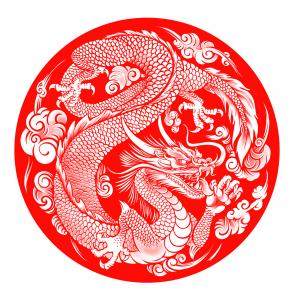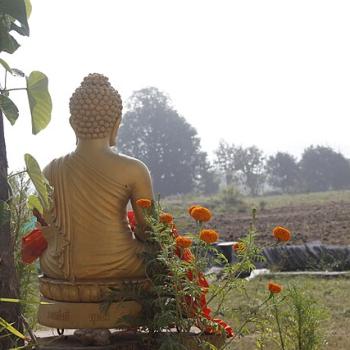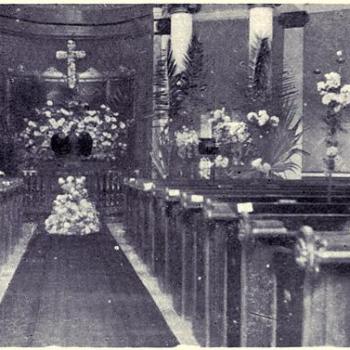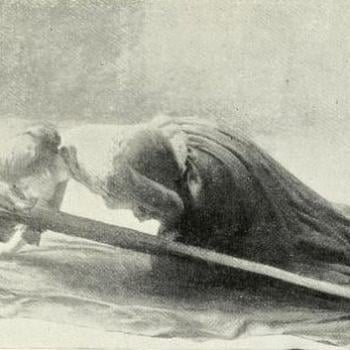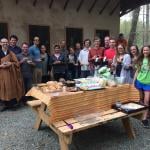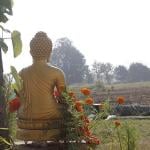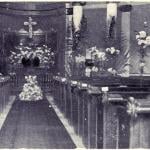AMONG THE SNAKES & DRAGONS
Mind Bubbles on North American Zen Lives in the Twenty-First Century
(A bit of a mess. A draft. To be worked on…)
James Ishmael Ford
“Ordinary people and saints live together. Dragons and snakes all mixed up.”
From the Blue Cliff Record, Case 35
Among the various maybes and possibilities of history is the suggestion that possibly a Chinese expedition including five Buddhist monks led by the Bhikshu Hui Shen touched at points along the California coast sometime before the fifth century of our common accounting. It’s unlikely, but I do enjoy thinking maybe, possibly.
The first truly reasonable assumption for Zen or Chan people actually here in North America would among the Chinese immigrants who came in the middle of the Nineteenth century. Gold Mountain as California was known in China, and indeed the whole Western coast was briefly a dream of possibilities for East Asians. Once here they created places of worship. And while mostly ad hoc, they must have had officiants and keepers of these places whether formal or informal. Sadly, we don’t really know much about the details. Still, what were originally called “joss houses” by the European descent folk absolutely existed. And it is no leap to assume these were places where people of the intimate way no doubt gathered.
Japanese immigrants would create perhaps the first unambiguously Zen communities here in North America. In 1922, after establishing a temple in Hawaii, the Reverend Hosen Isobe established a Soto Zen temple in Los Angeles. A couple of years later he founded another temple in San Francisco. Others would follow.
And here it is important to note a divide almost immediately happening.
Part of the sadness for the Buddhist sanghas in the West, like for their Christian counterparts, are the fairly harsh lines between ethnic communities from East and West. So, it is relatively rare to see someone of European or African descent in the communities originally gathered to support Japanese or Korean immigrants and their children, and now grandchildren. And similarly, not a lot of crossover from the birthright communities into the European descent or, now just beginning, African American led communities.
(As a quick aside, I’m also noticing how birthright and convert are to some degree becoming outdated terms. as increasingly there are people of European descent who were born into Buddhist identified families. Although it still seems at this time the larger majority of the European American majority communities were raised in non-Buddhist families.)
Half a century ago Dr Martin Luther King, Jr observed Sunday morning as the most segregated hour in America. The divides at our religious moments continue. And it has turned out to be no different for Buddhists. For the self-reflecting person this reveals one more aspect of what we currently call white supremacy. That we see similar harsh divides between the dominant ethnicity and various minorities in other cultures is pretty cold comfort.
Perhaps it’s impossible to separate out a religious community from a larger cultural identity. I participate in a Japanese descent congregation with historic Zen connections, but is organized more as a church. I vividly recall one coffee hour when an old member talked about how in the past people tried to make them “more Western,” banning some traditional marginally Buddhist Japanese holidays that were part of the church calendar. “We fixed that,” he said. I couldn’t help thinking he was eying me as a potential part of a hypothetical future attempt at taking over and the bad things that could follow.
Whatever the deeper truth of that particular incident, these divides certainly have been playing out within the importation of Buddhism to the West. For me this apparently unconscious repeating of ancient tribal-like patterns is harsh and sobering. Especially as in North America we live in cultures that rhetorically see themselves as expressly not based in where our ancestors came from. I’ve tasted just a bit of what that othering can look like when finding myself among Japanese Zen priests. And I hate, hate, how it happens to practitioners of Asian descent in our European dominant groups.
I find it all an invitation into humility. One I fail at constantly, but constantly aspire to. Frankly, what we fail at constantly, but into which we’re constantly invited. We’ve had some success in addressing gender equity, although it still is a work I progress. That has only worked because we all pay attention, and we all try to open our hearts. What we’re about in this project is too important for us to not confront our failings. Noticing this lacuna in my, and I suspect many people’s understanding of this tradition and its communities, invites further examination about the nature of religious communities, writ large. Although as I see it, for us specifically. Fortunately, there are those doing that hard work right now.
And this particular reflection is focused. It isn’t even concerned with Buddhism writ large in the West. But rather this is a consideration of the establishment of Zen communities, lineages, and training centers in North America. And what is happening as these communities emerge.
While, as I said, I have an ongoing relationship with a Japanese American community in Long Beach, for which I am deeply grateful; my principal participation continues to be among the emergent largely Western born and culturally European rooted communities. I should add it includes people of Asian descent, as well as increasingly people identifiable as Latinx and African-Americans. The lines demarcating this emergent pheneomenon is not hard, in fact sometimes the juiciest areas are where the divisions are in fact not so clear. That said there is something emerging.
And it has history. It has a story. And that story of this emerging community of practice can be outlined briefly.
In the years before the Second World War a handful of Zen teachers began to work with Westerners. Among them the Soto missionary Soyu Matsuoka, the lay Rinzai master Sokei-an, and the priest Nyogen Senzaki, a disciple of the renowned Rinzai master Soyen Shaku who himself visited America to participate in the 1893 World Parliament of Religions in Chicago.
Probably the most important thing for reaching the non-Asian community during these years were the writings of D. T. Suzuki, another disciple of Soyen Shaku, a lay Rinzai practitioner and scholar who wrote compellingly of something called Zen enlightenment. A British admirer, Alan Watts, took Suzuki’s writings and ran with it. Sokei-an’s America widow Ruth Fuller Sasaki would immigrate to Japan, ordain, and then lead a translation team who would join in the project begun by Suzuki in providing an increasing wealth of Zen materials in English. The Beats picked up the rhetoric, and Zen, and enlightenment, and koans, especially the sound of one hand clapping became a part of the intellectual counterculture.
In the 1950s and early 1960s a number of personalities central to the establishment of Zen as practice began to take their place here. Shunryu Suzuki representing Soto Zen, Rinzai priests Joshu Sasaki and Eido Shimano settled in America. Before the 1960s were over Hsuan Hua would bring Chinese Chan, while Thich Thein An and Thich Nhat Hanh brought Vietnamese Thien. Philip Kapleau, Robert Aitken, and Richard Baker would become the first Americans of European descent to be acknowledged as teachers. It wouldn’t be until 1972 that the Korean master Seung Sahn arrived, but his peripatetic nature quickly assuring a version of Korean Son would also become a widely available option. In the same year the Rinzai priest Sogen Omori established a training temple in Hawaii. Finally in 2007 the Korean Taego priest Jongmae Park initiated a domestic training program for North Americans and Europeans.
Some of these would not make significant inroads among converts. For instance, while the Venerable Hsuan Hua’s community is extensive, but only counts a handful of non-Chinese descent people. Although while this is largely true of the mission of the Venerable Sheng Yen, his dharma transmission to several lay heirs is becoming increasingly significant in our shaping North American and Western Zen.
That less direct influence can also be said of the Korean Jogye based communities in the West, although it should be noted the other Korean Zen organization, the Taego Order is now aggressive in attempting to bridge the gap between East and West.
I need to mark out Thich Nhat Hanh’s Interbeing Order here. It is large. He personally is terribly influential on the shape of the dharma in the West. But the organization he founded is also manifesting in sufficiently different ways than the other Zen-identified communities that I believe it should be studied either on its own or as part of the much larger manifestation of Buddhism come west.
As I write these words it’s the beginning of Spring in the year 2021. What I’ve come to think of as the “great die off” is beginning. The first generation of convert Zen practitioners and teachers, my generation are rapidly aging. Within two decades a goodly majority of us will have died. A decade after that, perhaps two or three extremely aged teachers will still be around to tell of the heady days when it all began. Maybe not even those two or three.
There are now some substantial Zen communities. The San Francisco Zen complex is perhaps the largest. Significant training centers exist around the country. There are literally hundreds of small centers. There are several training monasteries. And many teachers. There are three trans-lineage institutions for teachers, the Soto Zen Buddhist Association, the American Zen Teachers Association, and the Lay Zen Teachers Association.
Our teachers include monastics, priests, householders, men, women, and people who live variously within the fluidity of human sexuality. I have been particularly proud of how we’ve faced sexuality, and issues of gender. Again, nowhere near a done deal. But, there have been mind boggling changes in a few decades; and it shows us a way forward. And should give us hope.
Our communities tend to identify largely with the American progressive camp. I suspect largely because interest in religions outside of one’s birth communities comes with some of the freedoms that accompany higher education and higher income levels. Certainly, the demographics of the North American Zen communities show well educated people who at least began in the middle and upper middle classes. Again, for those who notice the demographics, class and access to Zen training for those not financially privileged joins the issues of race among the problematic issues of this emergent movement.
One of the most interesting things I’ve seen as I look at Zen as it is forming in the West is how there is no hard divide between a larger community of believers and a smaller professional class. When people speak of Zen ad their relationship to it, they almost always use the term “practice,” saying they are “Zen practitioners.” Not believers. Often, not even Buddhists. Practitioners. I will return to this later in this reflection.
There are no reliable numbers that I know of for this community. But, based on my observations, I’d hazard here in America, people of European, African, and Asian descent specifically committed to Zen and its disciplines as defined as North American Zen probably number between ten to fifteen thousand people. Those ten to fifteen thousand people are gathered into communities of practice and depth all across the country, although there is a weighting toward the West and East coasts. Almost all are small. Possibly with only one or two exceptions, all are very precarious.
And. Of course, there’s the die off coming. As small as our numbers are I believe there are enough younger people here and continuing to come in to pretty much assure there will continue to be a Zen presence. I suspect it will be dicey, but I am pretty sure something will continue.
What isn’t really clear is out of the plethora of Zen practices that are flowering, which are the ones that will survive? I look at the San Francisco Zen Center complex, with its three anchoring institutions, the City Center, Green Gulch, and its rural training temple Tassajara, as well as its various branches gathered as “Branching Streams,” and there is no doubt younger people are attracted and are committing to the rigors of their requirements, which include a five year residency. The other major institutions, the White Plum and the Kwan Um, while they have different expectations for their members, there remain serious commitments to practice.
The other two major lineages the White Plum, a Japanese derived lineage that is rooted in the Soto school but is heavily marked by the transmission of a reformed koan curriculum has at least as many participants as Branching Streams. However, while there is a historic home temple, the Zen Center of Los Angeles, the individual sub lineages are wildly diverse and the closer one looks the harder it is to see what holds it together beyond the lineage itself and perhaps a lingering admiration for its founder’s charismatic and visionary first successor among the converts, Bernie Glassman. The Kwan Um also has a center training temple in Cumberland, Rhode Island. It has a more centralized training program, but it has mutated from its founder’s vision of a combined monastic and householder leadership, becoming almost exclusively a lay organization.
I think I have to add in the rapidly growing Taego order as an organization that may have sticking power. And then there is the Soto Zen Buddhist Association. It sees its mission as providing a center for the various Soto lineages now represented in North America and to some degree elsewhere in the metaphorical west. Although it may be tested in the coming years with the development of a possible institution more closely under the control of the Soto Zen mission in North America.
Early in my Zen life, when I was a monastic at Shasta Abbey, a new monk joined our community. The buzz was how he was a fully transmitted Obaku priest, which we were given to understand was a subbranch of the Rinzai schools. As the weeks unfolded it came out that he had just made up these ordinations. While he was the first fraudulent teacher I would meet, over the years there have been many individuals some I’ve known personally, others I’ve just read of, who have decided the best route to teaching authority was simply to make up one’s authorizations.
As the years have progressed there have been fewer and fewer of these people who just make it all up. Sadly, I believe, because getting a “real” authorization has become very, very easy. For many years I was involved in the conversation about minimum standards within the Soto branches of our convert Zen communities. There tended to be three camps. There were those who wished to carry over the expectations of the Japanese Sotoshu. There were those who felt there needed to be substantial reforms to address the unique conditions here in the West and specifically North America. And there were those who felt dharma transmission was all that was required.
There is much to reflect on with the tradition of dharma transmission. And tied in with that: awakening. For dharma transmission I think the facts of its history and its various applications here in the West, we need to approach the matter with more humility, and caution. And we need constantly remind ourselves of the centrality of awakening. What awakening is, what it is not, and how our lives are actually expressions of some wild, fierce, terrible, endlessly lovely intimacy.
But these things that lapse into poetry need to manifest in prose.
The largest contingent among our emergent North American Zen are the various Soto lineages. The questions of alignment with the Sotoshu and its historic expectations have created fractures in the North American Soto community, and currently seems to be leading to the creation of a body that is directly under the control of the Japanese church in addition to the Soto Zen Buddhist Association, which was created with the encouragement of the Sotoshu to create a dialogue partner. Hard to say what will come of this.
The “we only need dharma transmission camp” has been the primary source of teachers with extremely limited formation. And there are a lot of them. They often gravitate to the inter webs. And their teachings tend to reflect a lot of reading if not a lot of practice, and often less actual encounter with the fundamental matters of the heart. Lots of right and wrong, not a lot of invitation into intimacy.
What is complicated is that some of them actually are wise and some among the wise seem able to guide others. I’ve been dragged grudgingly into acknowledging this fact. And, as I am no longer actively involved with those trying to create formal standards, I personally am able to just appreciate the complex fact on the ground, without having to try and help create institutional guidelines to allow for acknowledging these people.
There will always be those more concerned with titles. There will always be snakes with the dragons. Always. All that noted, I suspect for some time to come the backbone of our North American Zen will continue to be those attempting to adapt as closely as possible the patterns we’ve inherited, including expecting monastic experience as central to formation. But, also, there is very much a growing edge, seeking rigor in formation, but acknowledging we are no longer primarily a monastic movement. And seeing this seeking ways to continue to find depth in our paths without necessitating going into a monastery.
Not long ago I posted a query on social media at several sites devoted to Zen practice asking about what formation experiences were expected, the necessary if not sufficient conditions in forming priests and teachers. The information I gleaned was too disparate to be part of any quantitative reflection. But I did notice how some very significant contemporary Western Zen teachers in their years of formation and practice, did not have that significant monastic experience. And I suspect this is going to continue to be a significant element of our forming North American Zen community.
In Japanese Zen one who leads first spends time in the monastery, usually between one and three years, and usually then trundles off to the family temple and a life as a parish minister. Some stay and dig in. Among those some small number will be recognized as masters of the way. In Soto “dharma transmission” is bestowed around the time one assumes pastoral duties and the home temple. Mastery is usually associated with the title “shiki.” A shiki is the person allowed to lead a training monastery. Rinzai does not conflate that priestly authorization allowing one to lead that home temple with dharma transmission, instead reserving it for those who become shiki within their school.
In China and Korea there was no direct connection between ordination as a monk or nun and dharma transmission, although almost all who received dharma transmission were monastics. The Taego order holds several transmission lines, but its North American branch does not appear to transmit one. (I am pursuing this thread and welcome any clarifications) With the interesting footnote that in Europe a Kwan Um Zen master has crossed over to the Taego, bring Seung Sanhn’s transmission into the community. Although my point here, is that with or without formal transmission, the Taego seems as authentic as Soto, or, for that matter, Rinzai communities here.
But the bottom line is the assumption that some form of monasticism is what actual Zen practitioners do. Chinese versions are different than Japanese. There is no parish priest option, as in Japan. One’s practice is monastic. Or, for some, householder. The Kwan Um school was founded to be both monastic and lay. Over the years the monastic option has largely fallen away, leaving an organization where the majority of its teachers are householders.
And with that, returning to that idea of enlightened householders. The foundational literature of Zen is full of examples of enlightened lay practitioners. Some even receive dharma transmission. Always a minority, but from close to the beginning always an actual real option.
In truth all Asian cultures most householders don’t have formal practices. Instead, a believer embraces a life marked by devotion, and support of the “professional” practitioners sometimes as a practice, sometimes as a way of accumulating merit, and more likely mostly some combination.
That noted, there have always been those householders. And some have been practitioners.
And. So. Here they are. Here we are. Many making Zen and the intimate way a central part of lives that also have a significant experience within the world. Working. Marrying. Raising children. To one degree or another, a normative assumption of being a Zen person is being a Zen practitioner. And here we find that somewhere between ten and fifteen thousand people.
What this new category of spiritual practitioner is, doesn’t have a good name. Lay suggests not serious. It also implies professionals and those who consume their services. The new baseline for this convert community is the assumption everyone is a practitioner. Everyone sits with an ideal of regularity. Everyone wants, if possible, to sit in retreat even if it is for seven or five or three or one or even half days.
It is out of this milieu, this context of practice some are called into leadership. Insight is acknowledged, and traditional marks of spiritual care are expected by the community and are acknowledged within the rites of transmission.
A while back I had an opportunity to visit Bhutan. I know next to nothing about the Vajrayana and its variants. But through past good karma or flat out undeserved good fortune, there I was. And there I learned about what they called gomchen. These are people who do not take monastic vows, and stay in or close to community, but who are seen as fulfilling several sacred functions for the larger community. I kind of like it. And it covers both those who’ve ordained but live in the world and sometimes folk who’ve never formally ordained but are part still very much part of this third place between monastic and householder. I suspect there is something useful for us in our emerging North American Zen in this.
And it is something of how we’re approaching the matter. The primacy of sitting intimacy, and koan, the wild dance with precept, and allowing additional wisdoms to seep into the matter marks our way out.
I envision something blessed in this North American Zen, this Western Zen, this Third Way Zen. It is messy. It welcomes the snakes and the dragons. It is sometimes resplendent, more often it’s a bit shabby. It is always about awakening, the finding of a place that does not deny but invites us beyond the many differences and the one.
A calling to all hungry hearts. Ordinary people. And saints.
Our part of the intimate way.


